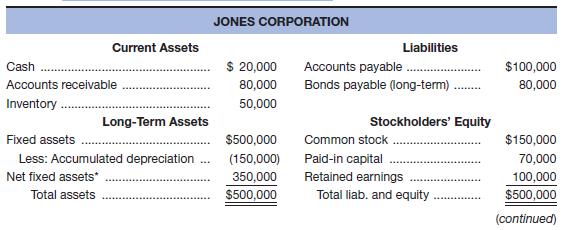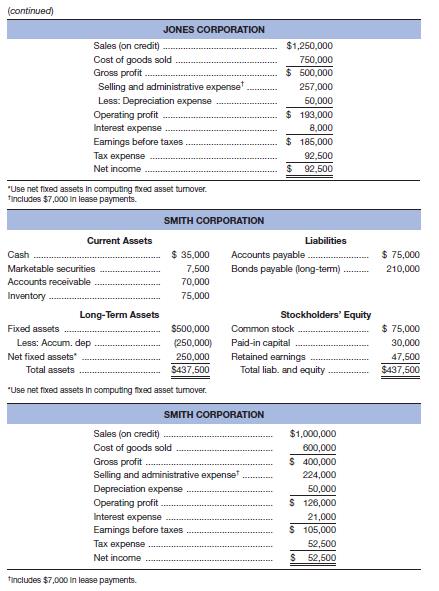
Concept explainers
Given the financial statements for Jones Corporation and Smith Corporation shown here:
a. To which one would you, as credit manager for a supplier, approve the extension of (short-term) trade credit? Why? Compute all ratios before answering.
b. In which one would you buy stock? Why?


a.
To calculate: The relevant ratios so that the decision for the extension of short term trade credit can be taken.
Introduction:
Shortterm trade credit:
It is the type of credit that is granted to a business or an individual or a fixed loan for a period of not more than 12 months or 1 year.
Answer to Problem 37P
The Smith Corporation would get the extension of the short term trade credit as their liquidity ratios are better than those of the Jones Corporation; the suppliers and lenders are most concerned with the liquidity ratios.
Explanation of Solution
Calculation of ratios for the Smith Corporation:
Calculation of current ratio:
Calculation of quick ratio:
Calculation of debt to total asset ratio:
Calculation of times interest ratio:
Calculation of fixed charge ratio:
Calculation of ratios for the Jones Corporation:
Calculation of current ratio:
Calculation of quick ratio:
Calculation of debt to total asset ratio:
Calculation of times interest ratio:
Calculation of fixed charge ratio:
b.
To determine: The company whose stock should be bought.
Introduction:
Stock:
Also termed as ordinary shares, it is a type of security that represents the corporate equity ownership. It is the best means to earn real rate of return ahead of inflation in the long run.
Answer to Problem 37P
The stocks of the Jones Corporation should be bought as their profit margin and return on assets are higher compared to the Smith Corporation; shareholders are mostly concerned with profitability.
But the return on equity is more for the Smith Corporation because it has taken a bigger financial risk. The times interest ratio and fixed charges ratio are higher for the Jones Corporation, which clearly reflects that their interest and fixed charges are well covered.
Explanation of Solution
Calculation of ratios for the Smith Corporation:
Calculation of profit margin:
Calculation of return on assets:
Calculation of return on equity:
Calculation of debt to total asset ratio:
Calculation of times interest ratio:
Calculation of fixed charge ratio:
Calculation of ratios for the Jones Corporation:
Calculation of profit margin:
Calculation of return on assets:
Calculation of return on equity:
Calculation of debt to total asset ratio:
Calculation of times interest ratio:
Calculation of fixed charge ratio:
Want to see more full solutions like this?
Chapter 3 Solutions
Loose Leaf for Foundations of Financial Management Format: Loose-leaf
- What are lines of credit? From the viewpoint of a short-term creditor, why do lines of credit increase a company’s liquid-ity? How are the unused portions of these lines presented in financial statements?arrow_forwardCritically Discuss the two statements below. A. Ratio is an expression of relationship between two or more items in mathematical terms. Ratio may be expressed as a:b (a is to b), in terms of simple fraction, integer, or percentage. B. A Finance Manager can utilize financial ratios and completely analyse any firm's financial performance without the need for any further financial review via any other company's data.arrow_forwardanalyze a campany's liquidity and solvency by using simple financial ratios. here you will answer questions relayed to saturn sales comapny ltd. analyze the both financial statements and answer the following question.arrow_forward
- IV. Conclusion: Based on your findings on ratio analysis and interpretation, what conclusion can you make? V. Recommendations: - What recommendations can you give to the company with regards to your findings? - What recommendations can you give to the investor with regards to your findings?arrow_forwardWhat information can best be elicited from a receivable ratio? A. company performance with current debt collection B. credit extension effect on cash sales C. likelihood of future customer bankruptcy filings D. an increase in future credit sales to current customersarrow_forwardA)Calculate the following ratios: • Return on Capital Employed (ROCE) • Current Ratio • Gearing Ratio • Price/Earnings (P/E) Ratio B) Based on the above ratios explain, which company George H. and James W. should invest in and discuss the limitations of your analysis.arrow_forward
- Discuss how do you analyze a company's performance using financial ratios? Which ratios are most important to look at for a creditor? Which ratios are most important to look at for a sharehold er?arrow_forwardDescribe why an Investor would use Profitability Ratio’s? What are the following ratio's measuring (i) Return on Assets, (ii) Return on Equity, (iii) Profit Margin. Describe why a CEO would use Activity Ratio’s? What are the following ratio’s measuring (i) Days Receivables Outstanding, (ii) Inventory Turnover. Describe why a Bank would use Solvency Ratio’s? What are the following ratio’s measuring (i) Current Ratio, (ii) Acid-Test, (iii) Debt Ratio, (iv) Debt to Equity Ratio, Times Interest Earned ratioarrow_forwardThe price/earnings ratio is commonly used by investors to OA. evaluate their ability to earn a return on their investment OB. determine the market value of the company OC. determine the market price per share of stock of a company OD. determine if the company has a low amount of debtarrow_forward
- with the help of the statement of income of the company attached please answer the below: 1: evaluate the companies on the basis of its financial strenght for lending purposes. will you select this company for lending? Why?arrow_forwardWhich of the following financial instruments gives a creditor relationship with the company? a. Preferred Stocks b. Bonds c. Receivables d. Common stocksarrow_forwardThe cost of equity is ________. Group of answer choices A. the interest associated with debt B. the rate of return required by investors to incentivize them to invest in a company C. the weighted average cost of capital D. equal to the amount of asset turnoverarrow_forward
- Principles of Accounting Volume 1AccountingISBN:9781947172685Author:OpenStaxPublisher:OpenStax College
 Cornerstones of Financial AccountingAccountingISBN:9781337690881Author:Jay Rich, Jeff JonesPublisher:Cengage Learning
Cornerstones of Financial AccountingAccountingISBN:9781337690881Author:Jay Rich, Jeff JonesPublisher:Cengage Learning

